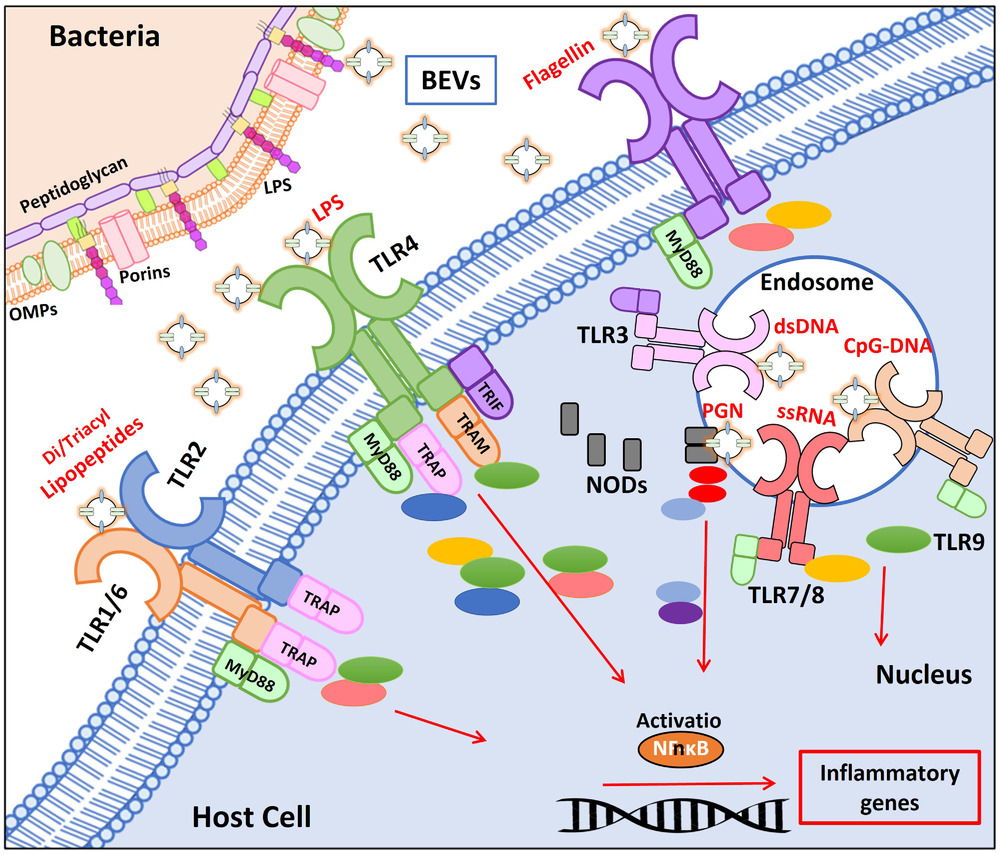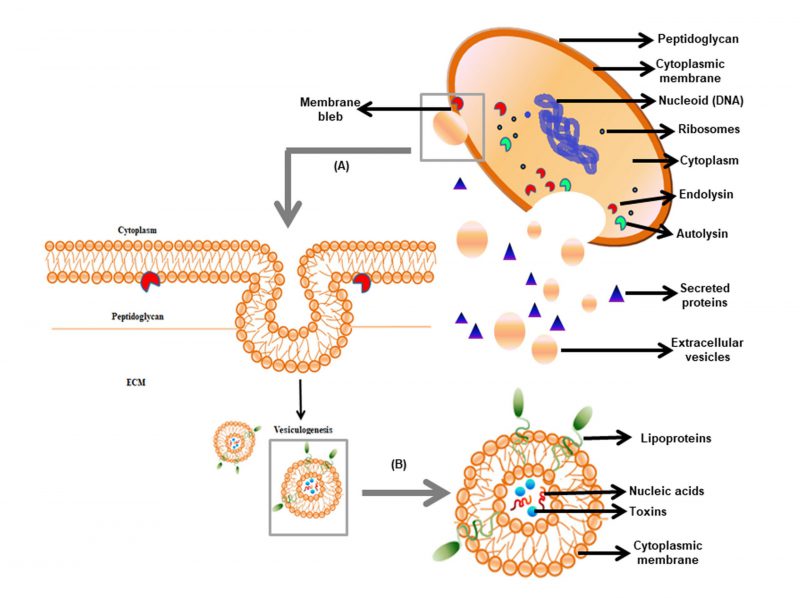Bacteria-derived Extracellular Vesicles Research and Applications
Bacteria-derived extracellular vesicles generally refer to nanoscale vesicles released by bacteria, such as Outer Membrane Vesicles (OMVs) or Nanovesicles (NVs). These are membrane-bound vesicles secreted by bacteria during growth and infection processes and are rich in functional molecules including proteins, lipids, polysaccharides, and nucleic acids. They play crucial roles in mediating communication between bacteria and hosts or other microbes, facilitating the transfer of virulence factors and horizontal gene transfer. Bacteria-derived extracellular vesicles possess inherent biological activity, immune modulation, and drug delivery capabilities and can be recognized by host cells to exert long-distance regulatory functions.
Bacteria-derived extracellular vesicles research and applications are widely used in fields such as infection mechanism studies, vaccine development, immunotherapy, and drug delivery systems. Virulence proteins and antigenic molecules within bacterial extracellular vesicles serve as important resources for vaccine and adjuvant development. Additionally, as natural nanocarriers, they can encapsulate drugs, RNA, proteins, and other molecules for targeted delivery. Moreover, bacterial extracellular vesicles demonstrate unique value in cancer immunotherapy, antimicrobial resistance research, and gut microbiota modulation, promoting their application in biomedicine, functional foods, and other industries.

Garrido, D N. et al. Journal of Extracellular Vesicles, 2021.
Figure 1. Recognition of Bacterial Extracellular Vesicles-Associated Molecular Patterns by Host Immune Receptors.
Services at MtoZ Biolabs
Based on high-efficiency extraction platforms such as ultracentrifugation and density gradient centrifugation, combined with advanced instruments including Transmission Electron Microscopy (TEM), Nanoparticle Tracking Analysis (NTA), and Mass Spectrometry , the bacteria-derived extracellular vesicles research and applications service provided by MtoZ Biolabs enables systematic characterization and component analysis of bacterial extracellular vesicles. The service covers vesicle extraction and purification, particle size and morphology detection, identification of protein/lipid/nucleic acid components, and functional validation (such as immune activity analysis). Ultimately, MtoZ Biolabs delivers a comprehensive extracellular vesicle component profile, functional data, and detailed experimental reports to support research in vaccine development, drug delivery, infection mechanisms, and other fields. Bacteria-derived extracellular vesicles mainly encompass the following aspects:
1. Outer Membrane Vesicles (OMVs) Derived from Gram-Negative Bacteria
OMVs are derived from Gram-negative bacteria such as Escherichia coli, Pseudomonas aeruginosa, and Helicobacter pylori, and are widely used in vaccine development, immune modulation, and antibiotic delivery. Due to their natural content of lipopolysaccharides (LPS), outer membrane proteins, and other components, OMVs possess strong immunogenicity and excellent delivery capabilities.
2. Membrane Vesicles Derived from Gram-Positive Bacteria
Membrane vesicles secreted by Gram-positive bacteria such as Staphylococcus aureus and Lactobacillus are released as nanoscale vesicles despite lacking an outer membrane. These vesicles are rich in virulence factors, enzymes, and metabolites, and are applied in regulating host immunity and maintaining microbiota balance, demonstrating unique mechanisms of action.
3. Extracellular Vesicles Derived from Probiotic Bacteria
Extracellular vesicles derived from probiotics such as Bifidobacterium and Lactobacillus are rich in signaling molecules that regulate gut microbiota. These vesicles exhibit functions including immune modulation, anti-inflammatory effects, and maintenance of intestinal barrier integrity. They are widely applied in the adjuvant treatment of metabolic diseases, inflammatory bowel disease, and in the development of functional foods.
4. Extracellular Vesicles Derived from Pathogenic Bacteria
Extracellular vesicles originating from pathogenic bacteria such as Mycobacterium tuberculosis and Neisseria meningitidis contain pathogen-associated molecules like toxins, enzymes, and RNA. These vesicles are essential for studying pathogenic mechanisms, identifying vaccine targets, and developing diagnostic and therapeutic strategies for infectious diseases.
5. Extracellular Vesicles from Engineered Synthetic Bacteria
Extracellular vesicles produced by genetically engineered bacteria are designed to perform specific functions, such as targeted delivery of RNA and anti-tumor drugs. These vesicles are applied in emerging fields like precision drug delivery and cancer immunotherapy, demonstrating highly controllable engineering features for advanced biomedical applications.
Service Advantages
1. Diverse Sources of Extracellular Vesicles
Covering a wide range of bacterial origins, including Gram-negative bacteria, Gram-positive bacteria, probiotics, and engineered bacteria, to meet the needs of various disease models and research directions. This diversity supports comprehensive exploration from basic scientific research to applied development.
2. Efficient Isolation and Precise Characterization
Relying on advanced techniques such as ultracentrifugation, density gradient separation, and immunoaffinity capture, combined with high-end analytical tools including Transmission Electron Microscopy (TEM), Nanoparticle Tracking Analysis (NTA), and mass spectrometry, to ensure high purity, superior quality, and comprehensive compositional analysis of bacterial extracellular vesicles.
3. Functional Activity Validation
Providing comprehensive functional assessments of extracellular vesicles in areas such as immune modulation, antibacterial effects, and delivery system efficacy. This includes in vitro cellular assays and in vivo animal model validation to support the selection of highly effective vesicles for vaccines, drug delivery, and disease treatment applications.
4. Personalized Customized Solutions
Offering flexible, one-stop services tailored to clients' research goals, including extracellular vesicle extraction, analysis, and functional testing. Covering the entire research pipeline from mechanistic studies to clinical translation, ensuring scientific rigor and practical applicability of research outcomes.
Applications
1. Microbiota Interaction and Mechanism Studies
Bacteria-derived extracellular vesicles research and applications enable the analysis of bacterial extracellular vesicles in mediating inter-bacterial and bacteria-host signaling, uncovering their crucial roles in maintaining gut microbiota balance, regulating inflammation, and contributing to chronic disease development.
2. Drug Delivery Systems
Leveraging the natural nanoscale structure and targeting abilities of bacterial extracellular vesicles to develop efficient delivery platforms for drugs, RNAs, proteins, and other bioactive molecules, supporting precision therapies for infections, cancer, and other diseases.
3. Immune Regulation and Antibacterial Therapy
Bacterial extracellular vesicles are rich in various immunologically active components that can modulate host immune responses, making them valuable tools for anti-infection therapies, immunotherapy, and microbiota modulation, with significant application potential.
4. Biomarker Development
Bacteria-derived extracellular vesicles research and applications focus on exploring specific proteins, RNAs, and other components within bacterial extracellular vesicles as potential biomarkers for infections, inflammation, cancer, and other diseases, promoting the advancement of liquid biopsy and precision medicine technologies.
Case Study
1. Extracellular Vesicles: An Emerging Platform in Gram-positive Bacteria
This study aims to explore the roles of Gram-positive bacterial extracellular vesicles (EVs) in bacterial biology and their application potential. The research focuses on Gram-positive bacteria, particularly the EVs they secrete. Methods include isolating and purifying EVs from various Gram-positive bacteria, followed by characterization of their morphology, size, and molecular components using transmission electron microscopy (TEM), nanoparticle tracking analysis (NTA), and mass spectrometry. The study also investigates the roles of EVs in inter-bacterial communication, antibiotic resistance transfer, and immune modulation. Results show that Gram-positive bacterial EVs carry diverse bioactive molecules, including proteins, RNAs, and metabolites, and play crucial roles in mediating bacterial communication, regulating immune responses, and contributing to antibiotic resistance dissemination. The study concludes that Gram-positive bacterial EVs hold significant roles in bacterial biology and present broad application prospects, especially in vaccine development, antibiotic resistance inhibition, and as drug delivery vehicles.

Bose, S. et al. Microbial Cell, 2020.
Figure 2. Origin and Composition of Gram-positive EVs.
FAQ
Q1: What Are the Differences Between Bacteria-derived Extracellular Vesicles and Animal-derived Exosomes?
A1: Bacteria-derived extracellular vesicles mainly contain bacteria-specific components such as lipopolysaccharides (LPS), bacterial toxins, and outer membrane proteins, which have strong immunogenicity and antigenicity. In contrast, animal-derived exosomes primarily consist of membrane proteins, RNAs, and lipids and are more involved in intercellular communication, showing significant differences in function and composition.
Q2: How Are Bacterial Extracellular Vesicles Isolated? Are they Difficult to Separate?
A2: Bacterial extracellular vesicles are typically isolated using ultracentrifugation, density gradient centrifugation, and membrane filtration techniques. Extraction protocols need to be optimized based on different bacterial strains and culture conditions to ensure the purity, activity, and functional integrity of the vesicles.
How to order?







